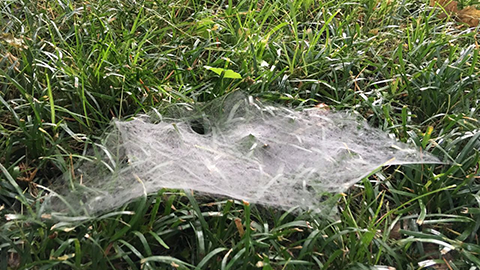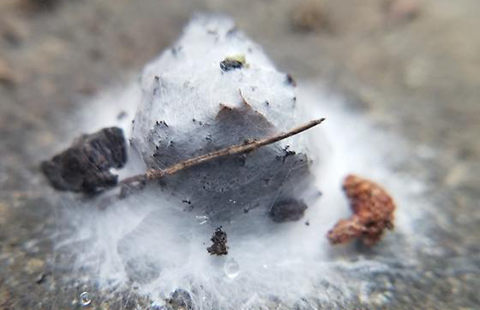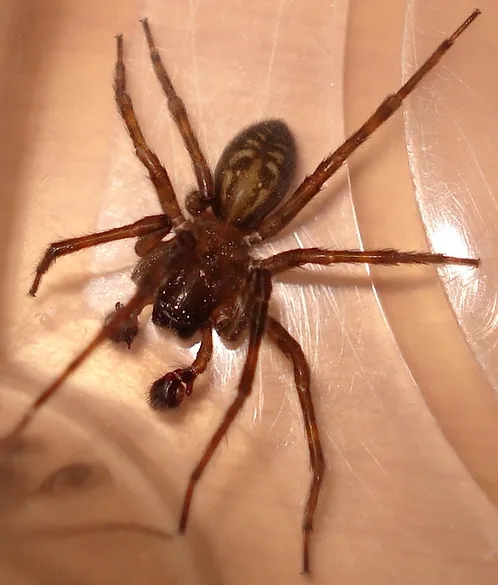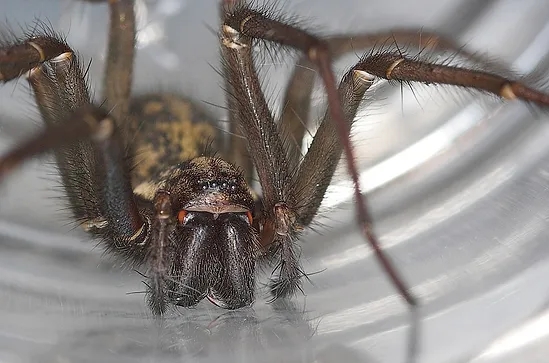Hobo Spiders (Tegenaria agrestis) Hobo Spider facts – These spiders belong to the Tegenaria family of spiders. The adult Hobo spider is a moderately large (12-18 mm body length) brown spider, with long, unmarked legs (legs included, a typical specimen would fit nicely on a silver dollar). The dorsal abdomen exhibits a “herringbone” or multiple chevron pattern, which may be quite obscure in darker individuals. The male sports two pedipalps (antennae like protuberances) between the two front legs, which are swollen at the ends, looking somewhat like a pair of boxing gloves; these “boxing gloves” are actually the male genitalia, not “fangs” or “poison sacs”.
The female generally has a larger abdomen than the male, and does not have swollen “boxing gloves” at the ends of the pedipalps. Several other spiders resemble hobo spiders; only an arachnologist, or other specifically trained person should attempt to make a positive identification of this species: In an instance where a spider has bitten a person, it is imperative to obtain positive identication only from a qualified professional arachnologist.
Hobo Spider bite
The hobo spider is a funnel-building spider. In the past, people believed its bite and venom were dangerous. However, scientists now believe this is not the case, and symptoms of a hobo spider bite are unclear.
Confirmed cases of hobo spider bites are rare. When there has been evidence of a hobo bite, the consequences were not serious.
People may believe they have been bitten by a hobo spider when the bite comes from another species, such as a brown recluse spider. However, a bacterial, fungal, or viral infection can cause similar symptoms.

Hobo spiders belong to the family Agelenidae or funnel web weavers which is indigenous to western Europe that was introduced into the north western United States (Port of Seattle) sometime before the 1930’s. The means of the spiders’ introduction into the United States was almost certainly commercial shipping vessels carrying cargo originating from agricultural areas of Europe.
It is highly probable that they were transported to and arrived in the Port of Seattle as egg cases attached to wood, etc., rather than as live spiders. Considering the seasonal nature of the Hobo Spider, it is highly unlikely that a viable breeding population would have developed in the United States based upon the occasional introduction of adult or juvenile specimens.
In its native Europe the Hobo Spider is a resident of fields, rarely entering human habitations due to the presence of major competitors, particularly the giant house spider, Tegenaria gigantea, which is a common resident of houses and other man-made structures in Europe; therefore, human contacts with the hobo spider are uncommon in Europe. In the United States however, the Hobo Spider rapidly adapted to living in urban areas, and without the widespread presence of a dominant competitor, became abundant and began to extend its range; by 1968 it had become established as far east as Spokane, Washington and Moscow, Idaho, and as far south as Corvallis, Oregon.
In the late 1960’s and early 1970’s physicians in Idaho, Oregon and Washington were presented with cases of probable spider bite that closely resembled bites caused by the brown recluse spider, Loxosceles reclusa. Studies conducted between 1974 and 1982 suggested that another spider was probably the actual agent of these bites. Finally, in 1983, field studies revealed that the Hobo Spider was the actual cause of such bites in the northwest, and the spiders’ ability to produce necrotic lesions and systemic illness was demonstrated in the laboratory in 1986.

The reason hobo spiders have a reputation for being so aggressive is because they have very poor eye sight and have to aggressively attack their prey to catch it. Their web is not sticky either which makes it harder for them to catch prey. Therefore with their poor eye sight, they think humans or anything that moves probably, are prey and attack. In around 50% of bites, no venom is injected so their reputation is probable overated too. However when it is injected, necrosis occurs and the resulting wound can take years to heal with much skin being eaten away!
Hobo Spider habitat
Hobo spiders are commonly found outdoors in sheltered areas. Places such as wood and rock piles, retaining walls, tall grass, and foundation cracks provide excellent places where they can make their characteristic funnel webs. The spider waits at the small hole at the bottom of the funnel for prey to make contact. It will then emerge from the hole to envenomate its prey.
Large hobo spiders aren’t designed to climb smooth surfaces in homes, such as painted walls. Consequently, when they enter homes, they are usually found at ground level in the basement because they cannot climb walls or slick surfaces to escape. A common place to find hobos is in the bath tub or sink because the porcelain or plastic is too slick for them to climb. However, this is not to say hobos can’t climb. They can easily climb textured surfaces such a fabric and carpet. Wandering males and females may occasionally become trapped in clothing, bedding, shoes, or other objects on the floor.
Hobo spiders are commonly found in dark areas such as flower beds, around the foundations of houses, and beneath rocks, woodpiles and areas where it can weave a funnel web. Indoors, they can be found in basements and in dark recesses, such as corners. Hobos are nocturnal, so generally they are discovered when the lights are turned on and the spider darts for cover.
Hobo spiders are poor climbers and are usually found at ground level. They sometimes climb up to a level of about four feet if the surface is sufficiently porous. If a hobo spider is discovered in a sink or bathtub, it arrived there by falling down the slick porcelain surface; it did not come up through the drain.
Hobo Spider size Giant House Spider (Tegenaria Gigantia) –
The Giant house spider (Tegenaria duellica; formerly known as T. gigantea) is a member of the genus Tegenaria and is a close relative of both the Domestic house spider and the infamous Hobo spider. The bite of this species does not pose a threat to humans or pets.
Females can reach 18 mm in length, with males having a slightly smaller body at around 12 mm to 15 mm in length. The female leg span is typically around 45 mm. The leg span of the male is highly variable, with spans between 25 mm to 75 mm being common.The Giant House Spider has the same coloration as the Domestic house spider; Earthy tones of brown and muddy red or yellow. They also have conspicuously hairy legs and abdomen.

GEOGRAPHY
Hobo spiders primarily exist in the Pacific Northwest, but their reach is expanding. Originally centered in Washington, Oregon, Idaho, and large parts of Montana, Wyoming and Canada, the hobo spider has moved eastward into Utah and Colorado, as well as some southern states.
DIET
To satisfy their hunger, hobo spiders attack their prey. They lie in wait at the rear of their funnel-shaped web, waiting for insects to unwittingly stumble into their trap. Their webs, constructed of overlying strands of silk, cause prey to become entangled. Once the prey is trapped, the spider quickly leaves its lair at the back of the tunnel and goes for the attack.
Where Do Hobo Spiders Live?
Hobo spiders live in dry, warm environments and prefer open fields as opposed to the inside of your home. They fear competition with other spiders, which contributes to their reluctance to go indoors.

What Do Hobo Spiders Eat?
Hobo spiders primarily eat insects like house flies and cockroaches, but will sometimes eat other spiders. Hobo spiders start their meal by first attacking their prey and then trapping it in their funnel-shaped webs. Their bodies are not designed to climb vertical walls, therefore their diet is composed of insects they can capture on ground level.
How Do You Treat a Hobo Spider Bite?
If bitten by a hobo spider, apply an ice pack to the bite, placing it on and off at ten-minute intervals. Their bites are venomous; however, they do not have much of an effect on humans. Elevate the area to reduce swelling and take an antihistamine or Benadryl to relieve itching. Clean the bite daily with soap and water to reduce the chances of an infection. One possible side effect of a hobo spider bite is slight nausea.
How Do You Get Rid of a Hobo Spider Infestation?
While uncommon, if you find that hobo spiders have moved into your home, vacuum the areas where any webs may reside. You can install sticky glue traps to catch the spiders or apply insecticide to baseboards, windows, doorways, cracks, and crevices to dispose of the spider and any insects it might feed on.
